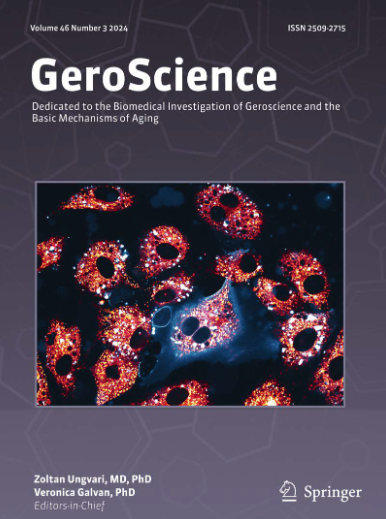犬尿氨酸途径失调通过QPRT的缺失驱动小鼠活动下降和代谢改变。
IF 5.3
2区 医学
Q1 GERIATRICS & GERONTOLOGY
引用次数: 0
摘要
慢性炎症途径的激活随着年龄的增长而增加,并且在流行病学上与多种与衰老相关的病理生理过程、表型(如身体虚弱和肌肉减少症)以及衰老生物体的早期健康寿命下降有关。尽管如此,直接将慢性炎症与这些疾病联系起来的分子机制仍然缺乏特征。我们假设慢性炎症通过“犬尿氨酸途径”(KP)增加膳食色氨酸降解为多种具有独特生理特性的代谢物,从而促进了年龄相关表型的发展。为了了解KP代谢产物升高对哺乳动物健康的影响,我们使用了喹啉酸磷酸核糖基转移酶敲除(QPRT-/-)小鼠,该小鼠缺乏KP的末端酶,因此产生下游犬尿氨酸水平升高。我们使用间接量热法在雄性和雌性、年轻、中年和老年小鼠中测试了这种突变对葡萄糖处理、自发运动活动、身体成分和代谢的影响。QPRT - / -小鼠的许多KP代谢物和烟酰胺水平显著改变。表型特征以性别特异性的方式变化,与年龄和性别匹配的小鼠相比,雌性QPRT-/-小鼠早在12个月时就出现了活性降低、瘦质量和摄氧量下降以及葡萄糖清除率受损。雄性QPRT-/-小鼠在中年时瘦体重减少,呼吸和食物摄入也发生了改变。这些数据表明,KP失调可以驱动哺乳动物活动下降和改变代谢,是干预虚弱和功能下降的潜在目标。本文章由计算机程序翻译,如有差异,请以英文原文为准。
Kynurenine pathway dysregulation via loss of QPRT drives declines in activity and altered metabolism in mice.
Chronic inflammatory pathway activation increases with age and is epidemiologically linked to multiple aging-related pathophysiological processes, phenotypes such as physical frailty and sarcopenia and early healthspan declines in aging organisms. Despite this, molecular mechanisms that directly connect chronic inflammation to these conditions remain poorly characterized. We hypothesize that chronic inflammation contributes to the development of age-related phenotypes by increasing the degradation of dietary tryptophan into multiple metabolites with unique physiological properties, called kynurenines, via the 'kynurenine pathway' (KP). To understand the impact of elevated KP metabolites on mammalian healthspan we utilized the quinolinate phosphoribosyltransferase knock-out (QPRT-/-) mouse which lacks the terminal enzyme of the KP and thus develops increased levels of downstream kynurenines. We tested the effects of this mutation on glucose handling, spontaneous motor activity, body composition and metabolism using indirect calorimetry, in male and female, young, middle aged and older mice. QPRT - / - mice had significantly altered levels of numerous KP metabolites and nicotinamide. Phenotypic characteristics varied in a sex-specific manner with decreased activity, lean mass and VO2, and impaired glucose clearance as early as 12 months seen in female QPRT-/- compared to age and sex-matched mice. Male QPRT-/- mice developed reduced lean mass by middle age and had altered respiration and food intake. This data indicates that KP dysregulation can drive declines in activity and alter metabolism in mammals and is a potential target to intervene on frailty and functional decline.
求助全文
通过发布文献求助,成功后即可免费获取论文全文。
去求助
来源期刊

GeroScience
Medicine-Complementary and Alternative Medicine
CiteScore
10.50
自引率
5.40%
发文量
182
期刊介绍:
GeroScience is a bi-monthly, international, peer-reviewed journal that publishes articles related to research in the biology of aging and research on biomedical applications that impact aging. The scope of articles to be considered include evolutionary biology, biophysics, genetics, genomics, proteomics, molecular biology, cell biology, biochemistry, endocrinology, immunology, physiology, pharmacology, neuroscience, and psychology.
 求助内容:
求助内容: 应助结果提醒方式:
应助结果提醒方式:


